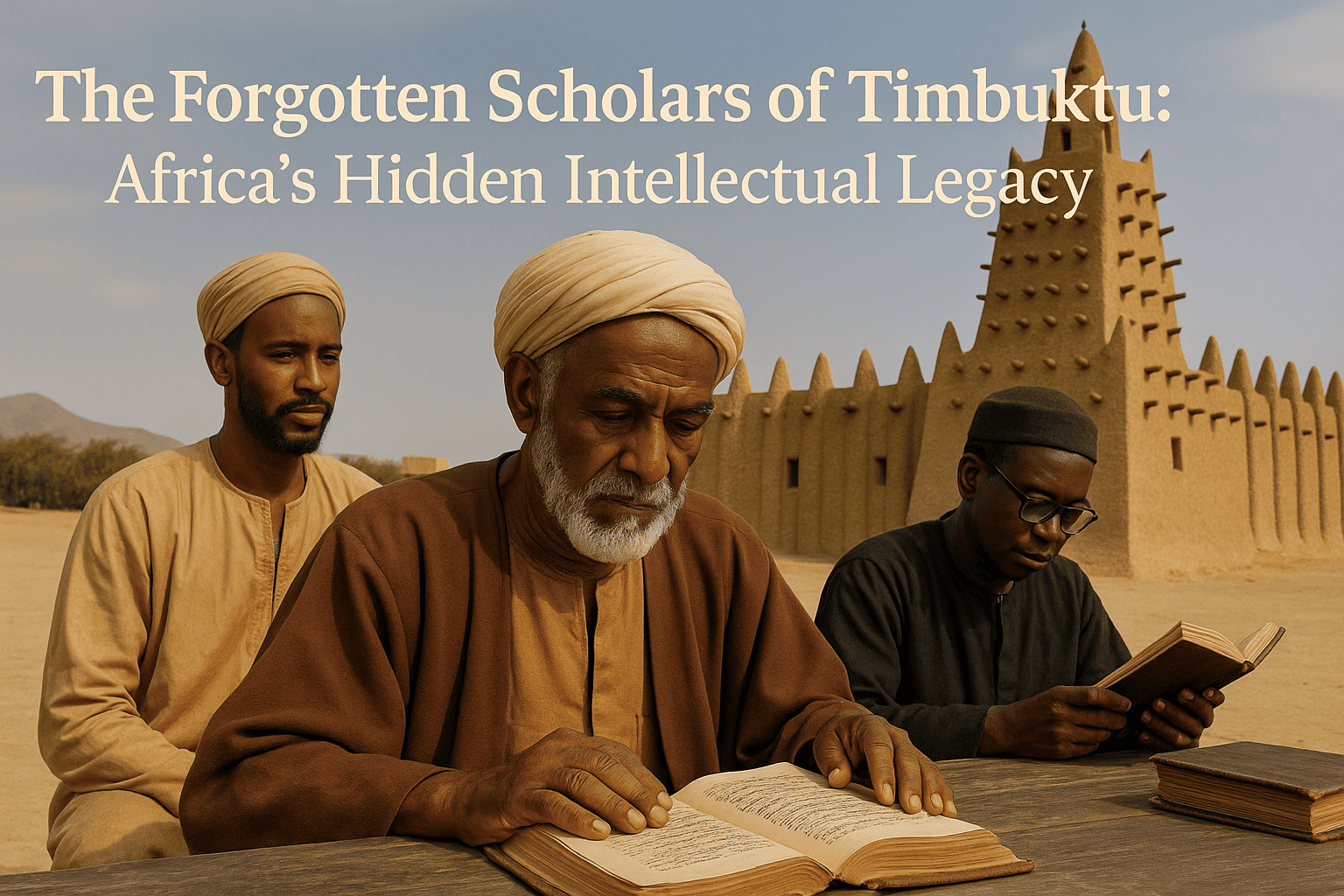Introduction
When most people think of intellectual history, they often envision ancient Greece, the European Renaissance, or China’s scholarly dynasties. Rarely does the African city of Timbuktu emerge as a prominent intellectual center. Yet from the 13th to the 17th centuries, Timbuktu was home to one of the greatest centers of learning in the Islamic world. This blog examines the overlooked scholarly legacy of Timbuktu—its universities, its vast manuscript archives, and the African scholars whose contributions rivaled their counterparts in Cairo, Baghdad, and Cordoba.
The Rise of Timbuktu as a Scholarly Hub
Located in present-day Mali, Timbuktu rose to prominence under the Mali Empire and later the Songhai Empire. Situated strategically near trans-Saharan trade routes, it attracted traders, theologians, poets, and scientists. By the 14th century, it had become an academic nexus, hosting students and scholars from across West Africa and the Islamic world.
Three main institutions—**Sankoré**, **Djinguereber**, and **Sidi Yahya**—functioned as universities, offering advanced instruction in law, theology, astronomy, medicine, and grammar. These institutions granted ijazah (certificates of mastery), similar to degrees.
The Manuscript Libraries of Timbuktu
One of the most remarkable aspects of Timbuktu’s legacy lies in its manuscripts. It is estimated that over **700,000 manuscripts** were produced and preserved over centuries, many of them handwritten in Arabic and African languages like Fulfulde and Songhay.
Subjects include:
– **Mathematics** and **astronomy**, with detailed lunar and solar calendars
– **Medicine**, covering herbal remedies, anatomy, and diagnosis techniques
– **Islamic jurisprudence** and theology, often specific to West African contexts
– **Philosophy**, logic, ethics, and even Sufi mysticism
These texts challenge the misconception that Africa lacked written tradition or scholarly rigor.
Key Scholars and Thinkers
– **Ahmad Baba al-Timbukti (1556–1627)**: A prolific scholar and political thinker, Ahmad Baba authored over 40 works and fiercely defended the intellectual capacity of black Africans. He criticized racism and was imprisoned by Moroccan forces after their invasion of Timbuktu.
– **Al-Aqib ibn Mahmud**, a 15th-century scholar who played a key role in establishing Sankoré’s curriculum.
– **Mohammed Bagayogo**, Ahmad Baba’s teacher, renowned for his legal and linguistic texts.
These figures not only preserved Islamic scholarship but localized it, integrating African perspectives into global discourse.
The Decline and Dispersal
Timbuktu’s decline began in the late 16th century after the Moroccan invasion of 1591. Scholars were exiled, libraries looted, and intellectual networks disrupted. Colonial narratives in the 19th and 20th centuries further obscured Timbuktu’s legacy, presenting it as a mythical or lost city, rather than a real academic center. The narrative of ‘African darkness’ erased centuries of documented intellectual life.
Modern Recovery and Preservation Efforts
Since the 1990s, there has been a renewed interest in Timbuktu’s manuscripts. Organizations like the **Ahmed Baba Institute**, **UNESCO**, and **SAVAMA-DCI** have worked to catalog, digitize, and preserve these texts.
During the 2012 conflict in Mali, thousands of manuscripts were smuggled out of Timbuktu by librarians and citizens, risking their lives to protect a heritage of knowledge.
Digital projects today aim to make these texts accessible to scholars worldwide, reasserting Africa’s place in the global history of ideas.
Why This History Matters
Reclaiming Timbuktu’s scholarly legacy reshapes how African history is taught and understood. It counters Eurocentric narratives and affirms that Africa has always been a participant in global intellectual currents—not just a recipient. By studying these manuscripts and institutions, we gain insight into African epistemologies, ethics, and innovations.
Conclusion
The story of Timbuktu is not one of legend but of legacy. Its scholars, texts, and institutions prove that Africa was—and remains—a cradle of knowledge and intellectual endeavor. By uncovering Timbuktu’s contributions, we not only honor a hidden history but also expand the boundaries of what global scholarship truly means.
References
– Hunwick, J. O. (2003). *Timbuktu and the Songhay Empire*. Brill.
– Saad, E. W. (1983). *Social History of Timbuktu*. Cambridge University Press.
– UNESCO: Timbuktu Manuscripts Project. https://en.unesco.org/
– SAVAMA-DCI. https://www.savama-dci.org/

